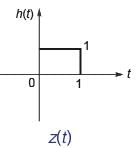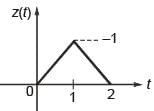GATE Exam > GATE Questions > Suppose for input x(t) a linear time-invarian...
Start Learning for Free
Suppose for input x(t) a linear time-invariant system with impulse response h(t) produces output y(t), so that x(t) ∗ h(t) = y (t). Further, if x(t) ∗h(t)= z (t) , which of the following statements is true?
- a)For some but not all t ∈(–∞, ∞), z(t) ≤ y (t)
- b)For all t ∈(–∞, ∞), z(t ) ≥ y(t )
- c)For all t ∈(–∞, ∞), z(t ) ≤ y(t )
- d)For some but not all t ∈(–∞, ∞), z(t) ≥ y (t)
Correct answer is option 'B'. Can you explain this answer?
| FREE This question is part of | Download PDF Attempt this Test |
Verified Answer
Suppose for input x(t) a linear time-invariant system with impulse res...
Since, y(t)= x(t) + h(t)
and z(t)= x(t) ×h(t)
Case - 1:
 and
and 
then,


Case-2:

then, y(t)= z(t)

Thus, z(t) ≥ y (t ), for all ‘t ’
and z(t)= x(t) ×h(t)
Case - 1:
 and
and 
then,


Case-2:

then, y(t)= z(t)

Thus, z(t) ≥ y (t ), for all ‘t ’
Most Upvoted Answer
Suppose for input x(t) a linear time-invariant system with impulse res...
Suppose for input x(t) a linear time-invariant system with impulse response h(t) produces output y(t), so that x(t) * h(t) = y(t), where * denotes convolution.
If we multiply both sides of the equation by a constant k, we get k * (x(t) * h(t)) = k * y(t). Since the system is linear, it follows that k * (x(t) * h(t)) = k * x(t) * h(t), where * now denotes scalar multiplication.
Therefore, k * x(t) * h(t) = k * y(t), which shows that scaling the input by a constant k results in scaling the output by the same constant k.
This property of linear time-invariant systems is known as the scaling property. It states that if the input is scaled by a constant, the output will also be scaled by the same constant.
If we multiply both sides of the equation by a constant k, we get k * (x(t) * h(t)) = k * y(t). Since the system is linear, it follows that k * (x(t) * h(t)) = k * x(t) * h(t), where * now denotes scalar multiplication.
Therefore, k * x(t) * h(t) = k * y(t), which shows that scaling the input by a constant k results in scaling the output by the same constant k.
This property of linear time-invariant systems is known as the scaling property. It states that if the input is scaled by a constant, the output will also be scaled by the same constant.

|
Explore Courses for GATE exam
|

|
Similar GATE Doubts
Suppose for input x(t) a linear time-invariant system with impulse response h(t) produces output y(t), so that x(t) ∗ h(t) = y (t). Further, if x(t) ∗h(t)= z (t) , which of the following statements is true?a)For some but not all t ∈(–∞, ∞), z(t) ≤ y (t)b)For all t ∈(–∞, ∞), z(t ) ≥ y(t )c)For all t ∈(–∞, ∞), z(t ) ≤ y(t )d)For some but not all t ∈(–∞, ∞), z(t) ≥ y (t)Correct answer is option 'B'. Can you explain this answer?
Question Description
Suppose for input x(t) a linear time-invariant system with impulse response h(t) produces output y(t), so that x(t) ∗ h(t) = y (t). Further, if x(t) ∗h(t)= z (t) , which of the following statements is true?a)For some but not all t ∈(–∞, ∞), z(t) ≤ y (t)b)For all t ∈(–∞, ∞), z(t ) ≥ y(t )c)For all t ∈(–∞, ∞), z(t ) ≤ y(t )d)For some but not all t ∈(–∞, ∞), z(t) ≥ y (t)Correct answer is option 'B'. Can you explain this answer? for GATE 2024 is part of GATE preparation. The Question and answers have been prepared according to the GATE exam syllabus. Information about Suppose for input x(t) a linear time-invariant system with impulse response h(t) produces output y(t), so that x(t) ∗ h(t) = y (t). Further, if x(t) ∗h(t)= z (t) , which of the following statements is true?a)For some but not all t ∈(–∞, ∞), z(t) ≤ y (t)b)For all t ∈(–∞, ∞), z(t ) ≥ y(t )c)For all t ∈(–∞, ∞), z(t ) ≤ y(t )d)For some but not all t ∈(–∞, ∞), z(t) ≥ y (t)Correct answer is option 'B'. Can you explain this answer? covers all topics & solutions for GATE 2024 Exam. Find important definitions, questions, meanings, examples, exercises and tests below for Suppose for input x(t) a linear time-invariant system with impulse response h(t) produces output y(t), so that x(t) ∗ h(t) = y (t). Further, if x(t) ∗h(t)= z (t) , which of the following statements is true?a)For some but not all t ∈(–∞, ∞), z(t) ≤ y (t)b)For all t ∈(–∞, ∞), z(t ) ≥ y(t )c)For all t ∈(–∞, ∞), z(t ) ≤ y(t )d)For some but not all t ∈(–∞, ∞), z(t) ≥ y (t)Correct answer is option 'B'. Can you explain this answer?.
Suppose for input x(t) a linear time-invariant system with impulse response h(t) produces output y(t), so that x(t) ∗ h(t) = y (t). Further, if x(t) ∗h(t)= z (t) , which of the following statements is true?a)For some but not all t ∈(–∞, ∞), z(t) ≤ y (t)b)For all t ∈(–∞, ∞), z(t ) ≥ y(t )c)For all t ∈(–∞, ∞), z(t ) ≤ y(t )d)For some but not all t ∈(–∞, ∞), z(t) ≥ y (t)Correct answer is option 'B'. Can you explain this answer? for GATE 2024 is part of GATE preparation. The Question and answers have been prepared according to the GATE exam syllabus. Information about Suppose for input x(t) a linear time-invariant system with impulse response h(t) produces output y(t), so that x(t) ∗ h(t) = y (t). Further, if x(t) ∗h(t)= z (t) , which of the following statements is true?a)For some but not all t ∈(–∞, ∞), z(t) ≤ y (t)b)For all t ∈(–∞, ∞), z(t ) ≥ y(t )c)For all t ∈(–∞, ∞), z(t ) ≤ y(t )d)For some but not all t ∈(–∞, ∞), z(t) ≥ y (t)Correct answer is option 'B'. Can you explain this answer? covers all topics & solutions for GATE 2024 Exam. Find important definitions, questions, meanings, examples, exercises and tests below for Suppose for input x(t) a linear time-invariant system with impulse response h(t) produces output y(t), so that x(t) ∗ h(t) = y (t). Further, if x(t) ∗h(t)= z (t) , which of the following statements is true?a)For some but not all t ∈(–∞, ∞), z(t) ≤ y (t)b)For all t ∈(–∞, ∞), z(t ) ≥ y(t )c)For all t ∈(–∞, ∞), z(t ) ≤ y(t )d)For some but not all t ∈(–∞, ∞), z(t) ≥ y (t)Correct answer is option 'B'. Can you explain this answer?.
Solutions for Suppose for input x(t) a linear time-invariant system with impulse response h(t) produces output y(t), so that x(t) ∗ h(t) = y (t). Further, if x(t) ∗h(t)= z (t) , which of the following statements is true?a)For some but not all t ∈(–∞, ∞), z(t) ≤ y (t)b)For all t ∈(–∞, ∞), z(t ) ≥ y(t )c)For all t ∈(–∞, ∞), z(t ) ≤ y(t )d)For some but not all t ∈(–∞, ∞), z(t) ≥ y (t)Correct answer is option 'B'. Can you explain this answer? in English & in Hindi are available as part of our courses for GATE.
Download more important topics, notes, lectures and mock test series for GATE Exam by signing up for free.
Here you can find the meaning of Suppose for input x(t) a linear time-invariant system with impulse response h(t) produces output y(t), so that x(t) ∗ h(t) = y (t). Further, if x(t) ∗h(t)= z (t) , which of the following statements is true?a)For some but not all t ∈(–∞, ∞), z(t) ≤ y (t)b)For all t ∈(–∞, ∞), z(t ) ≥ y(t )c)For all t ∈(–∞, ∞), z(t ) ≤ y(t )d)For some but not all t ∈(–∞, ∞), z(t) ≥ y (t)Correct answer is option 'B'. Can you explain this answer? defined & explained in the simplest way possible. Besides giving the explanation of
Suppose for input x(t) a linear time-invariant system with impulse response h(t) produces output y(t), so that x(t) ∗ h(t) = y (t). Further, if x(t) ∗h(t)= z (t) , which of the following statements is true?a)For some but not all t ∈(–∞, ∞), z(t) ≤ y (t)b)For all t ∈(–∞, ∞), z(t ) ≥ y(t )c)For all t ∈(–∞, ∞), z(t ) ≤ y(t )d)For some but not all t ∈(–∞, ∞), z(t) ≥ y (t)Correct answer is option 'B'. Can you explain this answer?, a detailed solution for Suppose for input x(t) a linear time-invariant system with impulse response h(t) produces output y(t), so that x(t) ∗ h(t) = y (t). Further, if x(t) ∗h(t)= z (t) , which of the following statements is true?a)For some but not all t ∈(–∞, ∞), z(t) ≤ y (t)b)For all t ∈(–∞, ∞), z(t ) ≥ y(t )c)For all t ∈(–∞, ∞), z(t ) ≤ y(t )d)For some but not all t ∈(–∞, ∞), z(t) ≥ y (t)Correct answer is option 'B'. Can you explain this answer? has been provided alongside types of Suppose for input x(t) a linear time-invariant system with impulse response h(t) produces output y(t), so that x(t) ∗ h(t) = y (t). Further, if x(t) ∗h(t)= z (t) , which of the following statements is true?a)For some but not all t ∈(–∞, ∞), z(t) ≤ y (t)b)For all t ∈(–∞, ∞), z(t ) ≥ y(t )c)For all t ∈(–∞, ∞), z(t ) ≤ y(t )d)For some but not all t ∈(–∞, ∞), z(t) ≥ y (t)Correct answer is option 'B'. Can you explain this answer? theory, EduRev gives you an
ample number of questions to practice Suppose for input x(t) a linear time-invariant system with impulse response h(t) produces output y(t), so that x(t) ∗ h(t) = y (t). Further, if x(t) ∗h(t)= z (t) , which of the following statements is true?a)For some but not all t ∈(–∞, ∞), z(t) ≤ y (t)b)For all t ∈(–∞, ∞), z(t ) ≥ y(t )c)For all t ∈(–∞, ∞), z(t ) ≤ y(t )d)For some but not all t ∈(–∞, ∞), z(t) ≥ y (t)Correct answer is option 'B'. Can you explain this answer? tests, examples and also practice GATE tests.

|
Explore Courses for GATE exam
|

|
Suggested Free Tests
Signup for Free!
Signup to see your scores go up within 7 days! Learn & Practice with 1000+ FREE Notes, Videos & Tests.


















